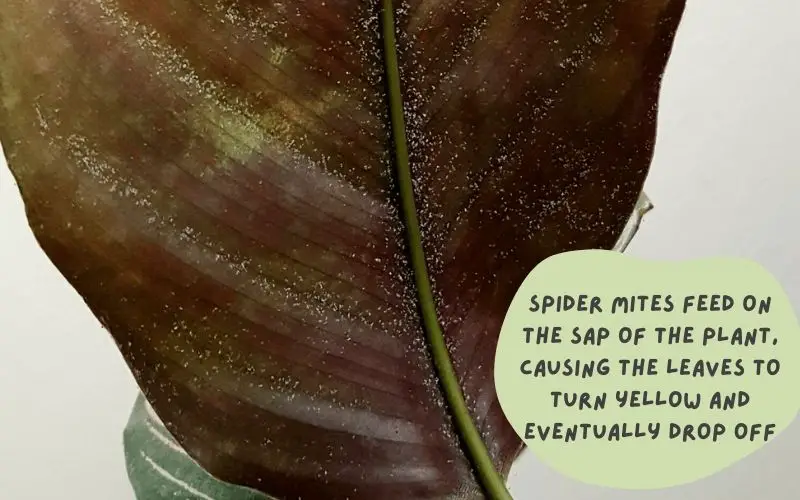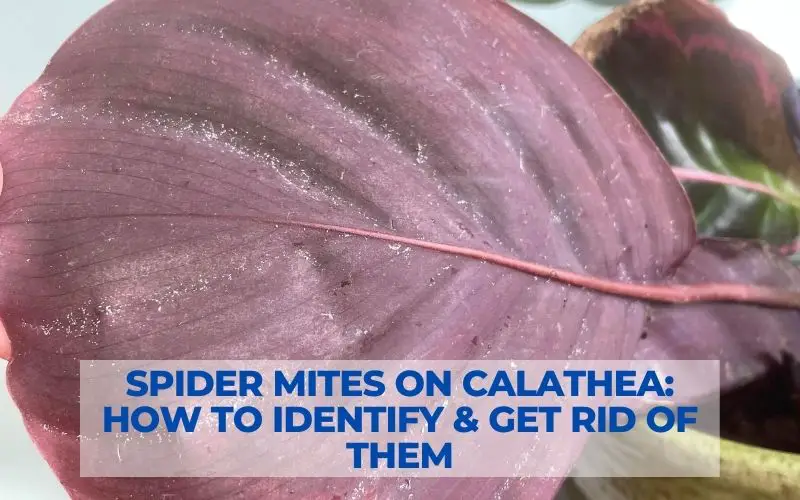If you have a Calathea plant, it’s important to be on the lookout for spider mites. These pests can cause serious damage to your plants if left untreated. In this blog post, we will discuss how to identify spider mites on Calathea plants and how to get rid of them.
What are spider mites?
Spider mites are tiny spider-like pests that feed on the sap of plants. They are usually red, brown, or green in color and can be difficult to see with the naked eye. Spider mites are a serious problem for Calathea plants because they can cause the leaves to turn yellow and eventually drop off.

How to identify spider mites on Calathea plants
There are a few telltale signs that you have spider mites on your Calathea plant. First, you may notice small webbing on the leaves or stems of the plant. Second, the leaves may begin to turn yellow or brown and feel crunchy to the touch. Finally, you may see small spider-like pests crawling on the plant. If you notice any of these signs, it’s important to take action immediately.
How do spider mites damage Calathea?
Spider mites can cause a great deal of damage to Calathea plants. These tiny pests feed on the sap of the plant, causing the Calathea leaves to turn yellow and eventually drop off. In addition, spider mites can also create webbing that can block off the light and air circulation, leading to further stress on the plant. If left unchecked, spider mite damage can eventually kill a Calathea plant.

How to Get Rid of Spider Mites on Calathea
Spider mites are tiny creatures that can wreak havoc on your Calathea plants. These pests thrive in warm, dry conditions and can quickly suck the life out of your plants. While there are many chemicals that you can use to kill spider mites, these products can also be harmful to your plants. Luckily, there are a few simple steps that you can take to get rid of spider mites naturally.
Step 1: Put your Calathea in quarantine
If one of your plants has spider mites inhabiting it, it’s only a matter of time before they spread to other plants. Relocate the infected plant apart from the other items in your collection. Better yet, if you can lock it away behind closed doors. Spider mites require a complete lockdown in this situation; social seclusion is insufficient.
Once your Patient Zero has been relocated, properly inspect the neighbors to look for mites (wash your hands first to avoid letting any pests hitch a ride with you).
In the early stages of an infestation, they are frequently difficult to spot. One tip is to shake or tap the stems while holding a sheet of white paper with no writing on it below the leaves. Mites are most likely to blame if the paper suddenly becomes coated with a large number of small dots that resemble fine pepper grains.
Step 2: Remove the Deadweight
Some of your Calathea’s leaves could already be so eaten up and shriveled when you discover that it has a spider mite infestation. Get rid of them since all they’re doing right now is giving mites a place to live.
Find a nice pair of pruning shears and clean them by wiping the blades with rubbing alcohol or a home bleach solution diluted by 10%. After that, cut off any withering or dead leaves. It’s not necessary to cut all the way to the ground since occasionally, a clipped stem will sprout new leaves halfway up. Between each snip, keep sanitizing your blades.
Step 3: Pick Your Weapons
Before the spider mites destroy your Calathea, you’ll need to apply some kind of chemical cure. The typical options include:
- Isopropyl alcohol: alson called rubbing alcohol. Use distilled water to dilute it at a 1:4 ratio.
Dish soap: Use an item free of harsh chemical additions, such as degreasers. This Dr. Bronners – Pure-Castile Liquid Soap is well-liked because it contains peppermint oil, which has some inherent pesticide qualities. About one teaspoon of soap should be added to one liter of warm water.
Hydrogen peroxide: The drugstore’s 3 percent quantity ought to be harmless to your Calathea and lethal to mites. - Neem oil: This organic insecticide kills and slows the reproduction of spider mites by interfering with their life cycle. Add 1 teaspoon of neem after stirring 13 teaspoons of soap into a liter of water to aid in the emulsification of the oil.
Make sure your selected solution is well-combined. Making a large batch is generally a good idea because you’ll need to apply it to your plant several times to completely get rid of the mites. Because Calatheas are sensitive to the chemicals frequently present in tap water, use distilled or filtered water whenever feasible.
Step 4: Spray Your Calathea Down
Fill a spray bottle with your mite-killing concoction after thoroughly stirring it. After that, spray your plant from the bottom to the top.
Try to be as exhaustive as you can. Spray the tops, bottoms, and stems of the leaves. Get into every crevice you can, including the tubes of freshly sprouting leaves that have been wrapped up. Spider mites may conceal themselves in the smallest cracks, and these chemicals only work on the mites that come into contact with the spray.
Step 5: Scrub the Stems and Leaves
For this stage, you can use a cotton pad or a microfiber cloth, but you could get better results with something a little more abrasive, like a paper towel or an old, scratchy cosmetics brush.
The same fluid you used to spritz down the plant, dip your wipe or brush in. Then, clean the foliage by beginning at the base of each leaf and working your way out to the margins from the center vein. To prevent the leaves from ripping, support them with your hand. In addition to killing the mites, this procedure also eliminates the webbing that shields them from liquid insecticides.
After cleaning the front and back of each leaf, go on to the stems and do the same. Similar to Step 4, accuracy is essential in this step. The fewer mites that are left after this mini-apocalypse, the less there will be for the plant to repopulate.
As you clean the plant, periodically reapply the mite-killer solution to your brush or towel. After you’ve removed the plant’s protecting webs, you might want to give your Calathea one more head-to-toe shower to be extra thorough. In the event that you employed a soap-containing mixture, rinse the foliage after letting it set for around 10 minutes.
Keep your Calathea out of any direct sunlight for at least a few days after using neem oil. Neem is a potent insecticide, but it makes sunburn more likely, and Calatheas are already susceptible to burning. Move your plant to a location where it only receives filtered or reflected light if it regularly gets a few hours of direct sun.
Step 6: Repetition and rotation
A single cleaning of your Calathea won’t be enough to get rid of all spider mites. Rarely do pests respond to a single treatment at every step of their life cycle. Within a few days, fresh hatchlings should appear.
That implies that you must return and exterminate the following generation as well as perhaps numerous generations beyond that. Until you’re certain the infestation has been eradicated entirely, treat your plant every 3-5 days.
Change up the chemical agent you employ as well; never subject the mites to the same treatment twice. Colonies of spider mites can quickly develop pesticide resistance due to their fast reproduction. You considerably lower the likelihood that they’ll develop a population-wide immunity by switching up your therapy.
How to prevent spider mites on Calathea
The best way to prevent spider mites on Calathea plants is to keep the area around the plant clean and free of debris. spider mites thrive in dirty, cluttered conditions. So, by keeping your Calathea plant’s surroundings clean, you can help discourage spider mites from taking up residence. You should also check your Calathea plant regularly for spider mites and take action immediately if you see any signs of an infestation. By following these simple tips, you can help keep your Calathea plant healthy and free of spider mites.
Cleanliness is key in preventing spider mites on Calatheas – be sure to keep the area around your plant free of debris. You should also check your Calathea plant regularly for spider mites and take action immediately if you see any signs of an infestation. By following these simple tips, you can help keep your Calathea plant healthy and free of spider mites.
Pesticides can be effective in getting rid of spider mites on Calatheas, but be sure to follow the instructions on the label carefully. Only use the pesticide as directed and take care to avoid spraying it on other plants or animals.
You can also discourage spider mites from taking up residence on your Calathea plant by keeping the area around the plant clean and free of debris. spider mites thrive in dirty, cluttered conditions. So, by keeping your Calathea plant’s surroundings clean, you can help discourage spider mites from making themselves at home.
By following these simple tips, you can help keep your Calathea plant healthy and free of spider mites. spider mites can cause serious damage to your plant if left untreated, so it’s important to take action immediately if you see any signs of an infestation. With a little bit of effort, you can keep your Calathea plant spider-mite free!
Other Calathea Pests
Spider mites aren’t the only pests that can affect Calatheas. Mealybugs, aphids, and scale insects can also cause problems for these plants. If you notice any of these pests on your Calathea, be sure to take action immediately. These pests can cause serious damage to your plant if left untreated.
Final Thoughts
spider mites can be a serious problem for Calatheas. If you notice any signs of an infestation, be sure to take action immediately. There are a few different ways that you can get rid of spider mites, but the best way to prevent them is to keep the area around your plant clean and free of debris. By following these simple tips, you can help keep your Calathea plant healthy and free of spider mites.


